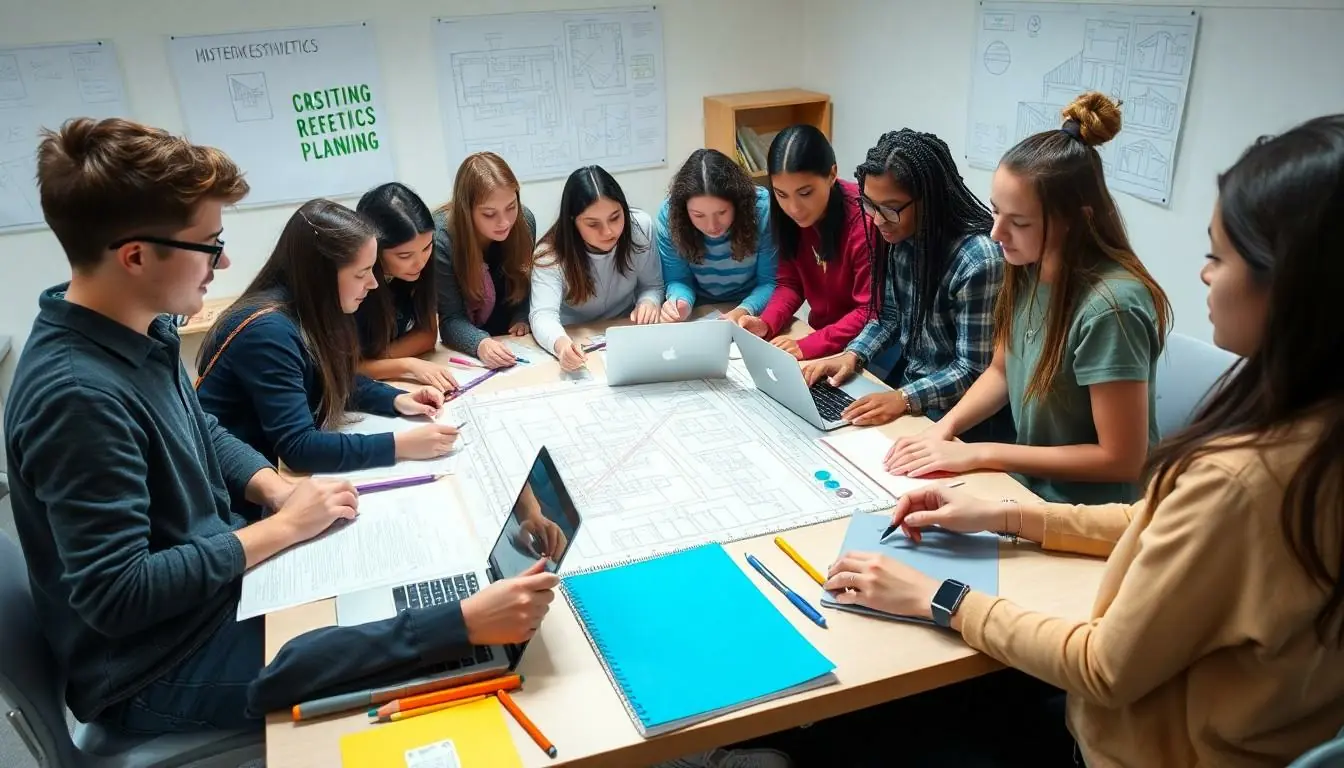Table of Contents
ToggleImagine a world where creativity meets structure, where blueprints become masterpieces, and where students don’t just learn about buildings—they build dreams. Design and architecture senior high isn’t just another academic path; it’s an exhilarating journey into the realms of innovation and artistry.
Overview of Design and Architecture Senior High
Design and architecture senior high programs offer a unique educational experience that merges creativity with technical knowledge. Students explore various disciplines, including graphic design, architectural drafting, and urban planning. By engaging in hands-on projects, they develop practical skills essential for the industry.
Courses typically emphasize critical thinking and problem-solving abilities. Students learn to analyze design principles, study historical architecture, and apply modern technologies. This comprehensive approach fosters a deep understanding of both aesthetics and functionality.
The curriculum may include software training in tools like AutoCAD and Revit. Mastering these programs enhances students’ ability to create professional designs. Projects often involve teamwork, encouraging collaboration among peers to achieve common goals.
Extracurricular activities further enrich the educational experience. Students participate in design competitions, workshops, and internships, gaining real-world insights. Networking opportunities through these engagements can lead to valuable connections in the field.
Career paths for graduates are diverse, covering areas such as interior design, landscape architecture, and urban development. Many graduates pursue higher education in design or architecture, while others enter the workforce directly.
Incorporating sustainability into design projects is increasingly important. Students learn to consider environmental impacts and explore innovative solutions. This focus on sustainability prepares them for the challenges of a rapidly changing world.
Overall, design and architecture senior high programs equip students with the competencies required for success in creative industries. They’re well-prepared to turn visions into reality, shaping the spaces of tomorrow.
Curriculum Highlights

Design and architecture senior high programs offer a rich curriculum that combines core subjects with specialized electives. Students engage with creative and technical aspects, gaining a comprehensive understanding of the field.
Core Subjects
Core subjects form the foundation of design and architecture programs. Classes typically include architectural design, graphic design, and drafting. Students learn to analyze and interpret design elements in various contexts. Critical thinking is emphasized, enabling students to evaluate historical architecture and its modern applications. Software training in tools like AutoCAD and Revit enhances their technical skills. Problem-solving exercises encourage innovative thinking. Exposure to real-world scenarios prepares students for practical challenges.
Elective Courses
Elective courses provide additional opportunities for exploration. Options may include landscape architecture and urban planning. Topics often cover sustainable design and materials. Workshops on 3D modeling and rendering develop students’ technical expertise further. Participation in design competitions enhances teamwork and communication skills. Internships often connect students with industry professionals, offering networking opportunities. These electives broaden career prospects in diverse fields such as interior design and urban development.
Extracurricular Activities
Extracurricular activities provide vital experiences for students in design and architecture senior high programs. These activities enhance learning and foster creativity and collaboration.
Clubs and Organizations
Clubs and organizations cater to diverse interests within design and architecture. Students can join design clubs focusing on various aspects, such as graphic design or sustainable architecture. Leadership opportunities emerge in student government or design-oriented groups. Workshops often enhance skills in specific software or techniques, such as 3D printing or architectural modeling. Members frequently share projects and ideas, creating a supportive network. Collaboration among clubs leads to innovative solutions and fosters community engagement.
Competitions
Competitions challenge students to apply their skills in real-world scenarios. Design contests often invite participation from local and national levels, promoting creativity and innovation. Students regularly showcase their projects, receiving feedback and recognition from industry professionals. Architecture challenges can include creating sustainable designs or urban planning solutions. Winning teams may gain scholarships or internships, enhancing their portfolios. Engagement in competitions builds teamwork, critical thinking, and resilience, essential qualities in the design and architecture fields.
Student Experiences
Design and architecture senior high students engage in both creative and technical learning environments. Their experiences shape their understanding of the industry.
Testimonials
Students frequently share their excitement about the hands-on projects. One student noted that designing a real building was an eye-opening experience. Another highlighted the importance of the collaborative workshops, which build teamwork and communication skills. Classes often spark inspiration, allowing students to explore their personal design styles. Feedback from instructors also provides valuable insights, helping students refine their techniques.
Success Stories
Success emerges from the diverse paths students take after graduation. A former student landed an internship at a prestigious architectural firm, showcasing her talent in a state-level design competition. Another graduate focused on landscape architecture, earning a scholarship for innovative project work. Students consistently secure positions in top universities, where they further develop their skills. Such accomplishments illustrate the effectiveness of design and architecture programs in preparing students for multifaceted careers.
Future Opportunities
Design and architecture senior high programs open numerous pathways for students pursuing careers in creative fields.
College Pathways
Students can advance their education through various college pathways. Many universities offer bachelor’s degrees in architecture and design, leading to licensure and specialization opportunities. Programs often emphasize critical thinking, design theory, and technical skills. Pursuing these degrees helps students stand out in competitive job markets. Some institutions provide dual-degree options, combining architecture with urban planning or environmental design. Scholarships are available for exceptional students, encouraging further exploration of design-related fields.
Careers in Design and Architecture
Career opportunities in design and architecture are diverse and plentiful. Graduates often find roles in fields such as interior design, landscape architecture, and urban development. Many professionals specialize in green building and sustainable design, aligning with industry trends focusing on environmental responsibility. Other avenues include working for architectural firms, government agencies, or starting individual design practices. Networking and internships during high school can lead to valuable employment connections, enhancing career prospects. Many positions also offer growth potential, allowing for ongoing learning and skill development in a dynamic environment.
Design and architecture senior high programs offer students a unique opportunity to blend creativity with technical skills. Through hands-on projects and specialized courses, they gain practical experience that prepares them for future careers in various design fields. The emphasis on teamwork and real-world application not only enhances their learning but also builds essential professional networks.
As they explore diverse paths within the industry, students are equipped to tackle the challenges of modern design while embracing sustainability. With a solid foundation in both theory and practice, graduates are well-positioned to shape the built environment and contribute meaningfully to their communities. This academic journey fosters a passion for innovation that lasts well beyond high school.







